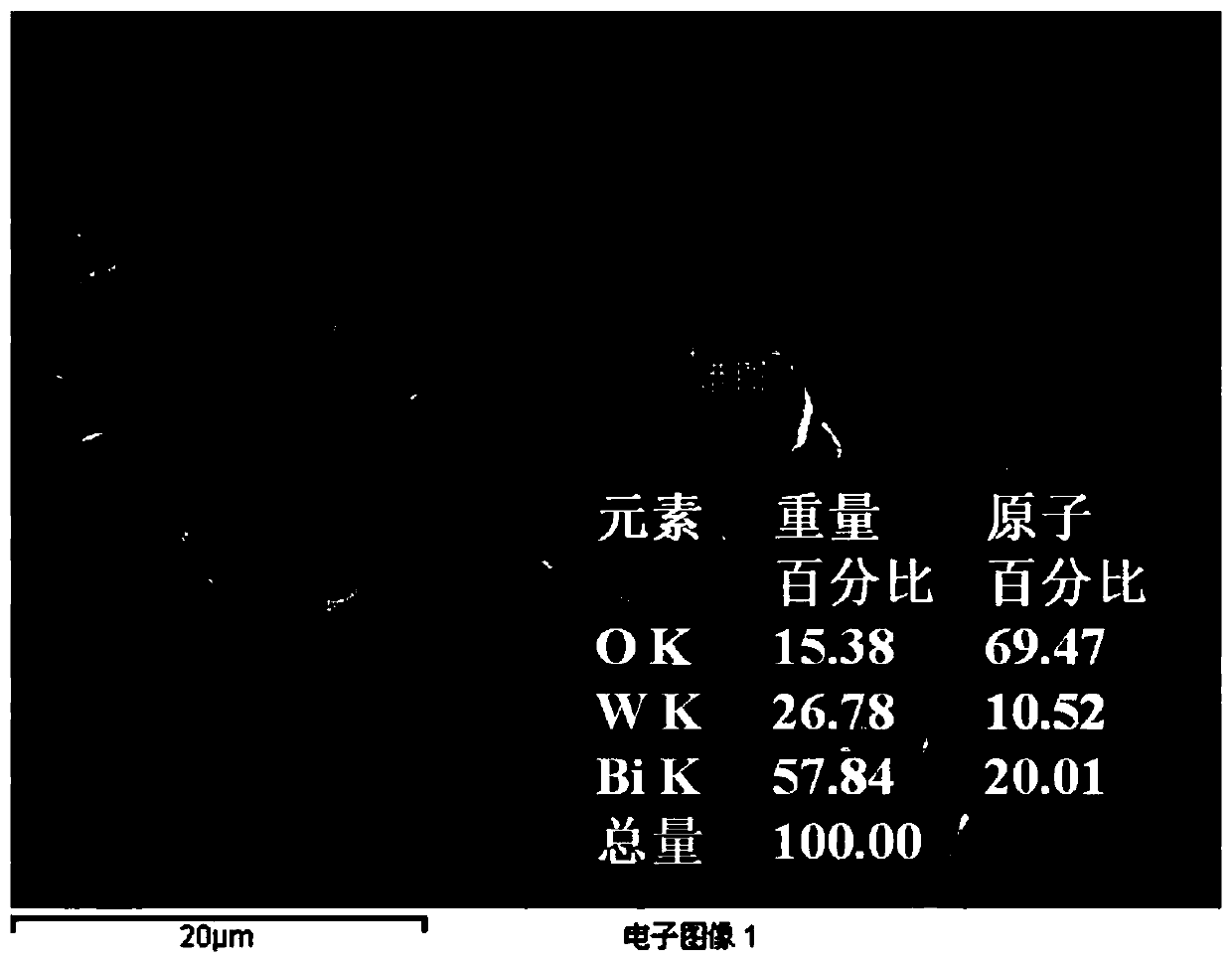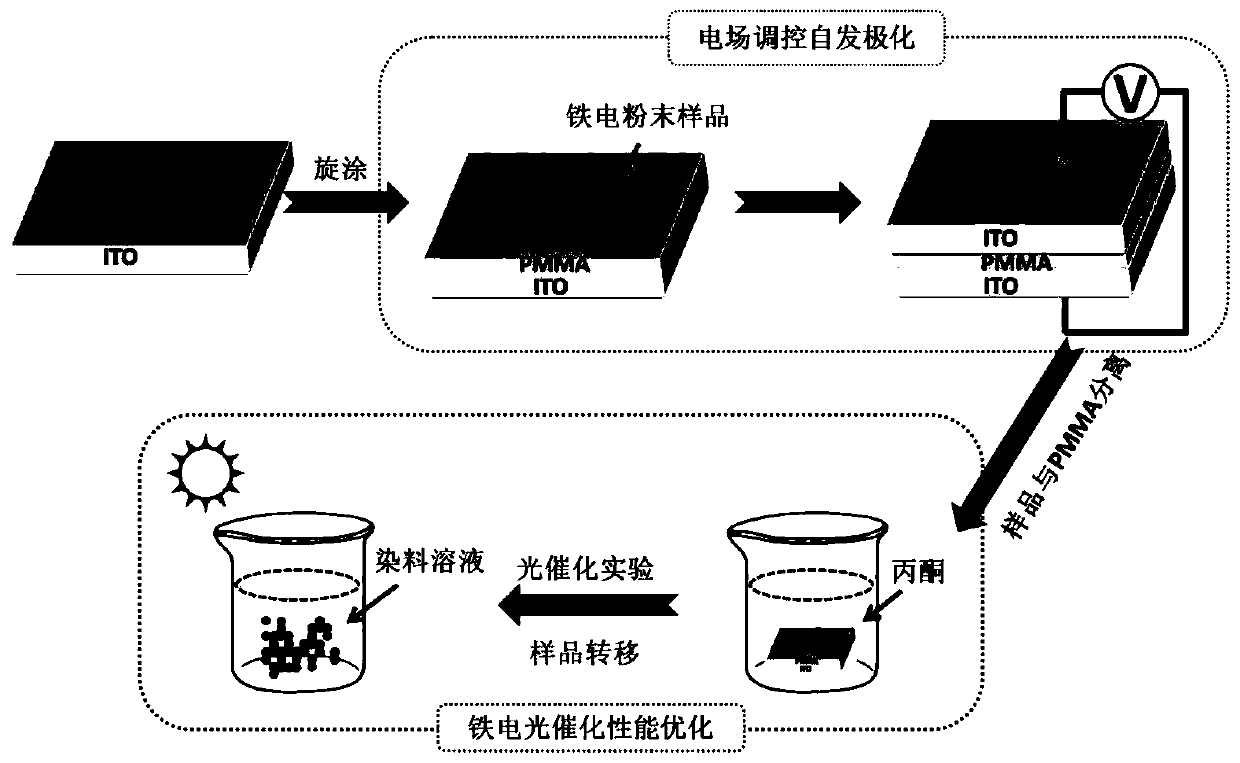A method to enhance the photocatalytic performance of ferroelectric materials by regulating spontaneous polarization
A ferroelectric material and spontaneous polarization technology, applied in chemical instruments and methods, physical/chemical process catalysts, organic compound/hydride/coordination complex catalysts, etc., can solve the problems of lack of control means and achieve photocatalysis Effects of performance improvement and photocatalytic performance improvement
- Summary
- Abstract
- Description
- Claims
- Application Information
AI Technical Summary
Problems solved by technology
Method used
Image
Examples
Embodiment 1
[0029] Bismuth tungstate (Bi 2 WO 6 ) to enhance the photocatalytic performance, specifically:
[0030] 1) Dissolving the soluble polymer material polymethyl methacrylate (PMMA) in ethyl acetate, the addition ratio is 0.5g PMMA dissolved in 10mL ethyl acetate solvent, stirring evenly on a magnetic stirrer to prepare a clear solution;
[0031] 2) Add 1g Bi directly to the above mixed solution 2 WO 6 Powder, mix the mixture evenly under continuous stirring;
[0032] 3) Take a small amount of the above mixed solution, and evenly drop it on the cleaned ITO conductive glass substrate, or spin-coat it on the conductive glass substrate through a coater to prepare an organic film with a thickness of less than 1mm;
[0033] 4) Transfer the above insulating film to an oven at 60°C for drying for more than 15 minutes, so that the ethyl acetate is fully volatilized, and a flat insulating film is prepared;
[0034] 5) Prepare another piece of the same material, whose size is slightly ...
Embodiment 2
[0039] Bismuth ferrite (BiFeO) controlled by an external electric field 3 ) to enhance the photocatalytic performance, specifically:
[0040] 1) Dissolving the soluble polymer material polymethyl methacrylate (PMMA) in ethyl acetate, the addition ratio is 0.5g PMMA dissolved in 10mL ethyl acetate solvent, stirring evenly on a magnetic stirrer to prepare a clear solution;
[0041] 2) Add 1g BiFeO directly to the above mixed solution 3 Powder, mix the mixture evenly under continuous stirring;
[0042] 3) Take a small amount of the above mixed solution, and evenly drop it on the cleaned ITO conductive glass substrate, or spin-coat it on the conductive glass substrate through a coater to prepare an organic film with a thickness of less than 1mm;
[0043] 4) Transfer the above insulating film to an oven at 60°C for drying for more than 15 minutes, so that the ethyl acetate is fully volatilized, and a flat insulating film is prepared;
[0044] 5) Prepare another piece of the same...
Embodiment 3
[0048] Tuning barium titanate (BaTiO) by applying an electric field 3 ) to enhance the photocatalytic performance, specifically:
[0049] 1) Dissolving the soluble polymer material polymethyl methacrylate (PMMA) in ethyl acetate, the addition ratio is 0.5g PMMA dissolved in 10mL ethyl acetate solvent, stirring evenly on a magnetic stirrer to prepare a clear solution;
[0050] 2) Add 1g BaTiO directly to the above mixed solution 3 Powder, mix the mixture evenly under continuous stirring;
[0051] 3) Take a small amount of the above mixed solution, and evenly drop it on the cleaned ITO conductive glass substrate, or spin-coat it on the conductive glass substrate through a coater to prepare an organic film with a thickness of less than 1mm;
[0052] 4) Transfer the above insulating film to an oven at 60°C for drying for more than 15 minutes, so that the ethyl acetate is fully volatilized, and a flat insulating film is prepared;
[0053] 5) Prepare another piece of the same mat...
PUM
 Login to View More
Login to View More Abstract
Description
Claims
Application Information
 Login to View More
Login to View More - R&D
- Intellectual Property
- Life Sciences
- Materials
- Tech Scout
- Unparalleled Data Quality
- Higher Quality Content
- 60% Fewer Hallucinations
Browse by: Latest US Patents, China's latest patents, Technical Efficacy Thesaurus, Application Domain, Technology Topic, Popular Technical Reports.
© 2025 PatSnap. All rights reserved.Legal|Privacy policy|Modern Slavery Act Transparency Statement|Sitemap|About US| Contact US: help@patsnap.com



